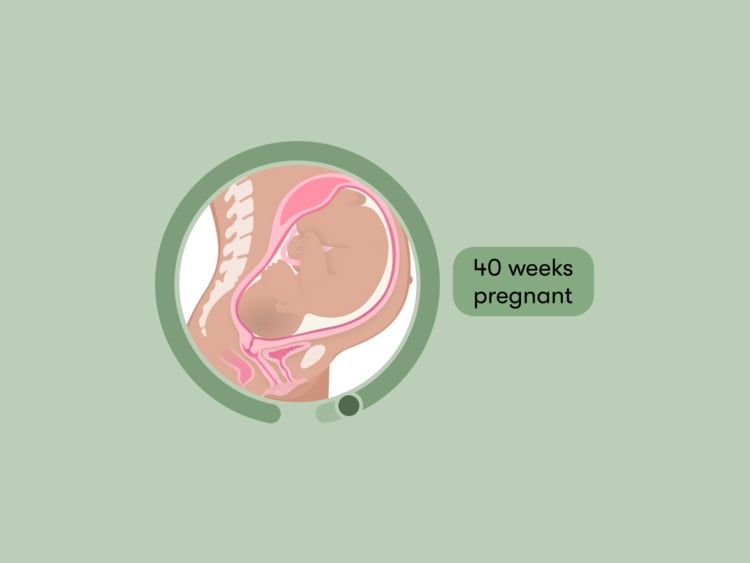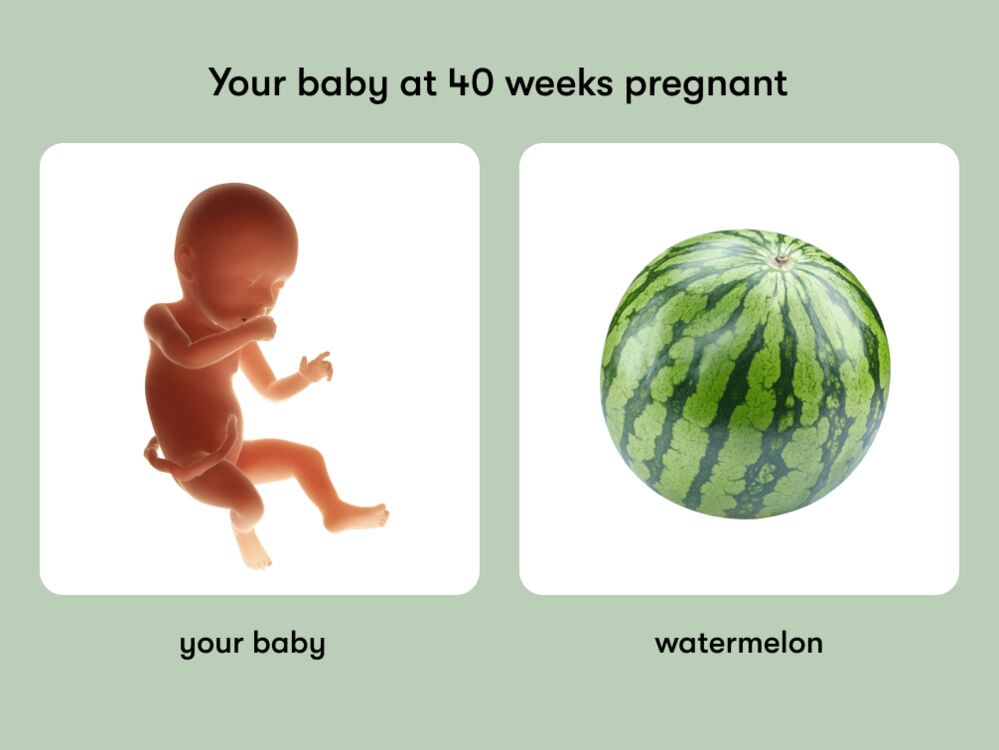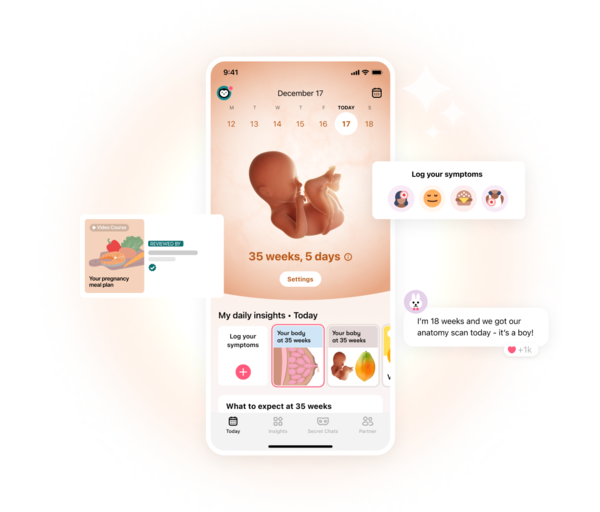From hints and tips for inducing labor to feeling comfortable at the end of pregnancy, here’s the lowdown on being 40 weeks pregnant.
-
Tracking cycle
-
Getting pregnant
-
Pregnancy
-
Help Center
-
Flo for Partners
-
Anonymous Mode
-
Flo app reviews
-
Flo Premium New
-
Secret Chats New
-
Symptom Checker New
-
Your cycle
-
Health 360°
-
Getting pregnant
-
Pregnancy
-
Being a mom
-
LGBTQ+
-
Quizzes
-
Ovulation calculator
-
hCG calculator
-
Pregnancy test calculator
-
Menstrual cycle calculator
-
Period calculator
-
Implantation calculator
-
Pregnancy weeks to months calculator
-
Pregnancy due date calculator
-
IVF and FET due date calculator
-
Due date calculator by ultrasound
-
Medical Affairs
-
Science & Research
-
Pass It On Project New
-
Privacy Portal
-
Press Center
-
Flo Accuracy
-
Careers
-
Contact Us
40 weeks pregnant: Your guide to this week of your third trimester


Every piece of content at Flo Health adheres to the highest editorial standards for language, style, and medical accuracy. To learn what we do to deliver the best health and lifestyle insights to you, check out our content review principles.
You may have been checking off the days on a calendar until your due date, and by week 40 of pregnancy, you may be days away from meeting your baby. While it’s tough to know when your baby will make their entrance into the world, 40 weeks is officially considered to be full term, so you could go into labor any day.
“Forty weeks is your due date, but babies really have a due month, so it’s normal for them to come before or after this date,” explains Dr. Allison K. Rodgers, reproductive endocrinologist, obstetrician, and gynecologist at Fertility Centers of Illinois, US.
Try not to worry if your due date arrives and passes. Most people give birth between 38 to 41 weeks of pregnancy. This might feel like a waiting game. From reading up on labor and delivery to checking and then double-checking your hospital bag, there’s only so much you can do to prepare for your baby’s arrival. So, here’s the lowdown on being 40 weeks pregnant.
Your baby at 40 weeks pregnant
Your baby is almost ready to be born
Your baby is almost ready to make their way into the world. As your due date approaches, your baby is continuing to gain weight, and there is much less room for them in your uterus. However, you should still feel them moving as much as before. The sensations might feel like a roll or a swish, and you may even be able to see your bump move with them.
At 40 weeks pregnant, many of their organs and systems (like their lungs, digestive system, and heart) are fully developed and are maturing.
Baby has lost their lanugo (layer of fine hairs)
You might remember that your baby had a layer of fine hair that covered their body which protected them and kept them warm in the uterus. This is called the lanugo. By 40 weeks, this has almost gone, but patches of it may remain when your baby is born.
How big is a baby at 40 weeks?
Length (crown to heel): 51 cm or 20.1 in
Weight: 3.6 kg or 8 lb
Size: Equivalent to a watermelon
All measurements are approximate and vary within the normal range.

Take a quiz
Find out what you can do with our Health Assistant
Your body at 40 weeks pregnant
You might experience sleeping problems
Many people associate sleepless nights with life with a newborn, but it can be hard to get a full night’s sleep during pregnancy too. As your baby is now around the size of a watermelon, it’s understandable if you feel more uncomfortable than before. Struggling to sleep during pregnancy can be caused by a multitude of things, including:
- Changes to your hormone levels
- Needing to pee more during the night
- Adapting as your bump grows
- Back, leg, and pelvic pain
Using a pregnancy pillow or supporting your bump and body with a pillow may ease some of the aches you have. You might also be feeling nervous about your approaching due date. You might have had the last nine months to grasp the way your life might change when your baby arrives, but it’s totally normal to experience nerves. Stress can impact your sleep too, so try to talk to a loved one about any worries you have, and if you have any questions or concerns about your pregnancy, don’t hesitate to speak to your health care provider.
You might experience contractions
At 40 weeks, it’s also crucial that you know some of the most common signs that labor isn’t too far away. They can include:
- Your water breaking: For some people, this can feel like a trickle, for others, a splash. Your water breaking describes when the sack that your baby has been growing in (which is filled with amniotic fluid) breaks. This might feel like you’ve peed, but rest assured that it’s totally typical. If you think your water has broken, call your health care provider.
- Feeling your baby has dropped lower in your uterus: This could mean they’re engaged for labor.
- Increased vaginal discharge: This could indicate that your mucus plug is coming out.
- Your cervix starts to dilate (Your doctor will have to check this.)
- Contractions: Contractions can feel like periodic tightening around your bump that gets progressively closer together and stronger.
You might have experienced Braxton Hicks contractions throughout your pregnancy and wondered how to spot false labor contractions from the real thing. If you notice a periodic tightening and relaxing sensation of your uterine muscles around your bump that gets progressively closer together and lasts around 60 to 90 seconds, this is an indication that you could be in labor.
Once you think you’ve started to have contractions, it’s helpful to time them so you can provide an outline to your health care provider of how long your contractions are lasting and how often they’re coming. If you’re experiencing them every five minutes for around 60 to 90 seconds each, then it’s time to call your hospital or health care provider.
Your questions answered
How long does it take to go into labor after 40 weeks?
While your due date gives you an indication of when your baby may arrive, it isn’t set in stone. It’s common to give birth before or after your due date, and it’s estimated that only a small percentage of babies are actually born on their due date (around 5%).
If you feel frustrated or disappointed that you haven’t given birth on your due date, then try to be gentle with yourself. It’s totally normal to feel uncomfortable and eager to meet your baby at this point in pregnancy, so prioritize doing things that you want to do. Rest when you need it, and treat yourself to watching your favorite TV show and taking relaxing walks.
What to expect at 40 weeks of pregnancy
Just like any other week of pregnancy, 40 weeks pregnant can look different for different people as no two pregnancies are the same. By your due date, you might feel fatigued and uncomfortable. In this case, it’s important to prioritize your rest and comfort. Alternatively, you might not feel much different from how you felt at 37, 38, and 39 weeks.
Is it OK to have a baby at 40 weeks?
A baby is considered to be full term if they’re born between 39 weeks and 40 weeks and six days, so it’s absolutely OK to have a baby at 40 weeks.
40 weeks pregnant checklist
Get ready for your baby’s arrival and familiarize yourself with the signs of labor
By 40 weeks pregnant, you may be keen to meet your baby and not be pregnant anymore. Carrying around a watermelon all day, every day is no joke, and if you’re feeling uncomfortable, it’s important to prioritize your rest and well-being.
Finding ways to get as much rest as you need may help you feel better in the days leading up to labor. This could mean taking naps throughout the day, booking a prenatal massage with a specialist, or going through some of your relaxing birthing aids, such as hypnobirthing or a playlist. Speaking about how you’re feeling about birth with loved ones may make you feel less daunted, and journaling during this time could be helpful when you’re processing feelings.
There’s also a community of parents-to-be and like-minded women waiting for you in Flo’s Secret Chats. There, you can swap personal stories and offer support via anonymous discussion boards.
Lastly, one practical way you can prepare for your baby’s arrival is to ensure you have a labor bag packed and ready to go with all of your essentials. This can include all of your toiletries as well as diapers and clothes for the baby. You might also want to pack your baby book and birth plan.
Hints and tips for inducing labor
During your third trimester, you may have heard some of the myths and tales that surround inducing labor. While they aren’t scientifically proven, some of them can be fun to try. They include:
- Having sex
- Hypnosis
- Eating dates
- Acupuncture
- Eating spicy foods (But don’t do this if you’ve been experiencing heartburn or indigestion. It’ll likely make it worse.)
When to consult a doctor at 40 weeks pregnant
At this point in your pregnancy, you might be having prenatal checkups as often as once a week. This can slightly differ depending on where you live. Since you could have your baby at any time, it’s crucial to know and watch out for signs that you’re going into labor. These include:
- Your water breaking
- Having regular contractions
- Losing your mucus plug
If you haven’t noticed any of the signs of labor, your doctor may have talked to you about an induction. This means using medication and other methods to bring on labor. If you have any questions about labor or induction, you don’t need to wait until your next appointment. However, at 40 weeks pregnant, you should contact your doctor immediately if you experience:
- Severe cramping
- Vaginal bleeding
- Unusual changes in vaginal discharge
- Fever
- Dizziness or fainting
- Severe vomiting
- Severe headaches or blurry vision
- Intense heartburn
- A decrease in the amount you feel your baby move
This isn’t an exhaustive list but just some examples of changes you should look for. Some of these can be a sign of health complications, so it’s essential that you speak to your doctor about the best next step for you. And if you’re ever worried about any other symptoms you experience during pregnancy, don’t hesitate to reach out to your health care provider.
40 weeks pregnant: The takeaway
At 40 weeks pregnant, you might be prepared for your baby’s arrival and feel very ready not to be pregnant anymore. While there isn’t much you can do at this point beyond getting a labor bag together and watching for the signs of labor, it’s crucial you feel comfortable, continue to do activities that bring you peace, and if you have any questions or worries don’t hesitate to speak to a loved one or your health care provider.


Hey, I'm Anique
I started using Flo app to track my period and ovulation because we wanted to have a baby.


The Flo app helped me learn about my body and spot ovulation signs during our conception journey.


I vividly
remember the day
that we switched
Flo into
Pregnancy Mode — it was
such a special
moment.
Real stories, real results
Learn how the Flo app became an amazing cheerleader for us on our conception journey.
References
“Week 37.” NHS, www.nhs.uk/start-for-life/pregnancy/week-by-week-guide-to-pregnancy/3rd-trimester/week-37/ Accessed 25 July 2023.
“Can Anything Bring Labour On?” Tommy’s, www.tommys.org/pregnancy-information/giving-birth/labour-and-birth-faqs/can-anything-bring-labour. Accessed 25 July 2023.
“Urgent Maternal Warning Signs.” Centers for Disease Control and Prevention, www.cdc.gov/hearher/maternal-warning-signs/index.html. Accessed 25 July 2023.
“What Natural Ways to Induce Labor Actually Work?” Cleveland Clinic, 4 May 2020, health.clevelandclinic.org/what-natural-ways-to-induce-labor-actually-work/.
“Fetal Development.” Cleveland Clinic, my.clevelandclinic.org/health/articles/7247-fetal-development-stages-of-growth. Accessed 25 July 2023.
“Fetal Positions for Birth.” Cleveland Clinic, my.clevelandclinic.org/health/articles/9677-fetal-positions-for-birth. Accessed 25 July 2023.
Friel, Lara A. “Fevers during Pregnancy.” MSD Manual Consumer Version, Sep. 2022, www.msdmanuals.com/home/women-s-health-issues/pregnancy-complicated-by-disease/fevers-during-pregnancy.
“Get a Good Night’s Sleep during Pregnancy.” Johns Hopkins Medicine, www.hopkinsmedicine.org/health/conditions-and-diseases/staying-healthy-during-pregnancy/get-a-good-nights-sleep-during-pregnancy. Accessed 25 July 2023.
Hellegers, Andre E. “Fetal Development.” Theological Studies, vol. 31, no. 1, Feb. 1970, pp. 3–9, https://doi.org/10.1177/004056397003100101.
“8 Best Ways to Improve Sleep during Your Pregnancy.” Cleveland Clinic, 13 May 2019, health.clevelandclinic.org/8-best-ways-to-improve-sleep-during-your-pregnancy/.
“How to Tell When Labor Begins.” The American College of Obstetricians and Gynecologists, May 2020, www.acog.org/womens-health/faqs/how-to-tell-when-labor-begins.
“Pregnant? Here’s How Often You’ll Likely See Your Doctor.” Cleveland Clinic, 14 Jan. 2022, health.clevelandclinic.org/prenatal-appointment-schedule/.
Khambalia, Amina Z., et al. “Predicting Date of Birth and Examining the Best Time to Date a Pregnancy.” International Journal of Gynaecology and Obstetrics, vol. 123, no. 2, Nov. 2013, pp. 105–09 doi: 10.1016/j.ijgo.2013.05.007.
“Kick Counts.” Cleveland Clinic, my.clevelandclinic.org/health/articles/23497-kick-counts. Accessed 25 July 2023.
“Lanugo.” Cleveland Clinic, my.clevelandclinic.org/health/body/22487-lanugo. Accessed 25 July 2023.
“Morning Sickness: Nausea and Vomiting of Pregnancy.” The American College of Obstetricians and Gynecologists, www.acog.org/womens-health/faqs/morning-sickness-nausea-and-vomiting-of-pregnancy. Accessed 25 July 2023.
“Myth or Fact? How to Induce Labor Naturally.” Penn Medicine Lancaster General Health, www.lancastergeneralhealth.org/health-hub-home/motherhood/your-pregnancy/myth-or-fact-how-to-induce-labor-naturally. Accessed 25 July 2023.
Nicholson, James M., et al. “New Definition of Term Pregnancy.” JAMA, vol. 310, no. 18, 13 Nov. 2013, pp. 1985–86, doi:10.1001/jama.2013.277993.
“Overdue Pregnancy: What to Do When Baby’s Overdue.” Mayo Clinic, 27 July 2022, www.mayoclinic.org/healthy-lifestyle/pregnancy-week-by-week/in-depth/overdue-pregnancy/art-20048287.
“Heartburn during Pregnancy.” Cleveland Clinic, my.clevelandclinic.org/health/diseases/12011-heartburn-during-pregnancy. Accessed 25 July 2023.
Reynolds, S. R. “The Uses of Braxton Hicks Contractions.” Obstetrics and Gynecology, vol. 32, no. 1, July 1968, pp. 134–40.
“Science of Sleep: What Is Sleep?” Harvard Medical School Division of Sleep Medicine, sleep.hms.harvard.edu/education-training/public-education/sleep-and-health-education-program/sleep-health-education-47. Accessed 25 July 2023.
“Prenatal Massage Benefits and Safety.” Cleveland Clinic, 8 Nov. 2022, health.clevelandclinic.org/prenatal-massage/.
“Signs of Labor: Know What to Expect.” Mayo Clinic, 16 Dec. 2021, www.mayoclinic.org/healthy-lifestyle/labor-and-delivery/in-depth/signs-of-labor/art-20046184.
“Water Breaking.” Cleveland Clinic, my.clevelandclinic.org/health/symptoms/24382-water-breaking. Accessed 25 July 2023.
“Water Breaking: Understand This Sign of Labor.” Mayo Clinic, 17 Nov. 2021, www.mayoclinic.org/healthy-lifestyle/labor-and-delivery/in-depth/water-breaking/art-20044142.
“Signs That Labour Has Begun.” NHS, www.nhs.uk/pregnancy/labour-and-birth/signs-of-labour/signs-that-labour-has-begun/. Accessed 25 July 2023.
“Tiredness and Sleep Problems.” NHS, www.nhs.uk/pregnancy/related-conditions/common-symptoms/tiredness/. Accessed 25 July 2023.
“Vaginal Discharge in Pregnancy.” NHS, www.nhs.uk/pregnancy/related-conditions/common-symptoms/vaginal-discharge/. Accessed 25 July 2023.
“Bleeding during Pregnancy.” The American College of Obstetricians and Gynecologists, May 2021, www.acog.org/womens-health/faqs/bleeding-during-pregnancy.
“Your Baby’s Movements in Pregnancy: Patient Information Leaflet.” Royal College of Obstetricians and Gynaecologists, Feb. 2019, www.rcog.org.uk/for-the-public/browse-all-patient-information-leaflets/your-babys-movements-in-pregnancy-patient-information-leaflet/.
History of updates
Current version (25 September 2023)
Published (24 February 2019)
In this article

Get your personal guide to pregnancy with the Flo app
-
Follow your baby's growth week by week
-
Get expert info on symptoms, safe foods, and more
-
Chat with other parents-to-be




